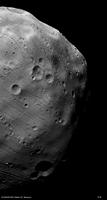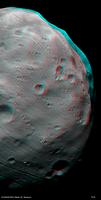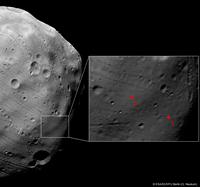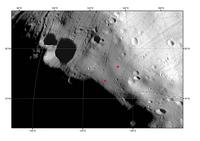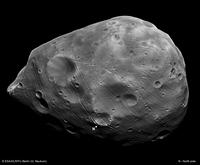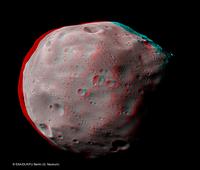Navigation/Menü: Links auf weitere Seiten dieser Website und Banner
15.03.2010
ESA's Mars Express spacecraft orbits the Red Planet in a highly elliptical, polar orbit that brings it close to Phobos every five months. It is the only spacecraft currently in orbit around Mars, whose orbit reaches far enough from the planet to provide a close-up view of Phobos.
Phobos flyby orbital characteristics animation (Overview) 
|
| Movie: Copyright ESA/DLR/FU Berlin (G. Neukum) |
|
[Download Movie] (with rightclick and "Save as...") |
Like our Moon, Phobos always shows the same side to the planet, so it is only by flying outside the orbit that it becomes possible to observe the far side. The other spacecraft presently orbiting Mars do so at much lower altitudes, and therefore only see the planet-facing side of the moon. NASA's Mars Odyssey (MO) and Mars Reconnaissance Orbiter (MRO) are in a low orbit around Mars and will never get as close to Phobos as Mars Express.
|
This image has additionally been enhanced photometrically for better bringing features in the less illuminated part. Resolution: about 4.4 meters per pixel
Image: Copyright ESA/DLR/FU Berlin (G. Neukum) |
|
The High Resolution Stereo Camera (HRSC) onboard the ESA spacecraft Mars Express took the images for this stereo composite of the surface of the moon Phobos on 7 March 2010. Due to the stereo viewing geometry during the flyby a small part of the moon's edge is only visible for the right eye resulting in odd 3D-perception in this area. Image data were taken from a distance of 130 km with a spatial resolution of about 4.4 meters per pixel in orbit 7915.
Image: Copyright ESA/DLR/FU Berlin (G. Neukum) |
In 2011/12 the Russian Federal Space Agency will send a mission called Phobos Grunt (meaning Phobos Soil) to land on the Martian moon, collect a soil sample, and return it to Earth for analysis. For operational and landing safety reasons, the potential landing sites for this spacecraft were selected on the anti-Martian side of Phobos within the area 5°S-5°N, 230°-235°E. This is why new HRSC images showing the vicinity of the landing area with higher resolution or other improved sightings such as a real coverage or sun lighting conditions than during the previous flybys (July-August 2008) of Phobos by the Mars Express spacecraft are so interesting for mission support.
|
HRSC nadir-channel image of Phobos with a resolution of 4.4meter per pixel in Orbit 7915. The blown-up portion of the image shows the proposed landing sites (S1, S2) for the Phobos Grunt spacecraft.
Image: Copyright ESA/DLR/FU Berlin (G. Neukum) |
|
The blown-up portion of the image shows the proposed landing region and sites for the Phobos Grunt spacecraft with overlaid coordinate system in Orbit 7915. (Local offsets are possible)
Image: Copyright ESA/DLR/FU Berlin (G. Neukum) |
|
Phobos flyby orbital characteristics animation (Close-up including spacecraft attitude animation) 
|
| Movie: Copyright ESA/DLR/FU Berlin (G. Neukum) |
|
[Download Movie] (with rightclick and "Save as...") |
The irregular 27 km × 22 km × 19 km body will be imaged at each pass by the High Resolution Stereo Camera (HRSC) (also partly images taken by the SRC with a 4.3 fold higher resolution) with the exception of the closest flyby on 3 March. This pass is devoted to high-precision determination of the gravity field of Phobos by Doppler tracking by the MaRS experiment and all other experiments will be shut off for avoiding any interference. The origin of Phobos is debated: it appears to share many surface characteristics with the class of carbonaceous C-type asteroids, which suggests it might have been captured from this population. However, it is difficult to explain either the capture mechanism or the subsequent evolution of the orbit into the equatorial plane of Mars. An alternative hypothesis is that it formed in its present position, and is therefore a remnant from the planetary formation period.
|
This image has additionally been enhanced photometrically for better bringing out features in the less illuminated part. All images are contrast-enhanced and geometrically adjusted for flight movements. Resolution: about 9 meters per pixel.
Image: Copyright ESA/DLR/FU Berlin (G. Neukum) |
|
The High Resolution Stereo Camera (HRSC) on board the ESA spacecraft Mars Express took the images for this stereo composite of the surface of the moon Phobos on 10 March 2010. The image data were taken from a distance of 278 km with a spatial resolution of about 9 meters per pixel in orbit 7926. All images are contrast-enhanced and geometrically adjusted for flight movements. The anaglyph has also been slightly geometrically adjusted at the left rim of the Phobos image to correct for viewing conditions.
Image: Copyright ESA/DLR/FU Berlin (G. Neukum). |
Phobos Flybys by Mars Express in 2010
| Date | Orbit | Distance in km |
Best HRSC nadir resolution in m/px |
SRC images resolution in m/px |
| 9 January 2010 | 7719 | 5370 | 182 | no images |
| 16 January 2010 | 7742 | 4420 | 150 | no images |
| 1 February 2010 | 7800 | 4557 | 154 | 41 |
| 5 February 2010 | 7813 | 5100 | 173 | 46 |
| 22 February 2010 | 7872 | 3908 | 132 | 35 |
| Current Flyby Sequence | ||||
| 3 March 2010 | 7904 | 67 | no images | no images |
| 7 March 2010 | 7915 | 130 | 4.4 | no images |
| 10 March 2010 | 7926 | 278 | 9 | 2.6 |
| 13 March 2010 | 7937 | 478 | ||
| 16 March 2010 | 7948 | 663 | ||
| 19 March 2010 | 7959 | 850 | ||
The High Resolution Stereo Camera (HRSC) experiment on the ESA Mars Express Mission is led by the Principal Investigator (PI) Prof. Dr. Gerhard Neukum who also designed the camera technically. The science team of the experiment consists of 40 Co-Investigators from 33 institutions and 10 nations. The camera was developed at the German Aerospace Center (DLR) under the leadership of the PI G. Neukum and built in cooperation with industrial partners (EADS Astrium, Lewicki Microelectronic GmbH and Jena-Optronik GmbH). The experiment on Mars Express is operated by the DLR Institute of Planetary Research, through ESA/ESOC. The systematic processing of the HRSC image data is carried out at DLR. The scenes shown here were created by the PI-group at the Institute for Geological Sciences of the Freie Universitaet Berlin in cooperation with the German Aerospace Center (DLR), Institute of Planetary Research, Berlin.
Further information:
- Univ.-Prof. Dr. Gerhard Neukum
Freie Universitaet Berlin
Fachbereich Geowissenschaften
Fachrichtung Planetologie und Fernerkundung
Mobile: +49 171-7647177
Telefon: +49 30 838 70579; +49 30 838 70575 (Sekr.)
Email: gneukum@zedat.fu-berlin.de - Prof.Dr. Ralf Jaumann
Deutsches Zentrum für Luft- und Raumfahrt (DLR)
Institut für Planetenforschung, Planetengeologie
Tel.: +49 30 67055-400
Fax: +49 30 67055-402
Email: ralf.jaumann@dlr.de - Olivier Witasse
ESA Mars Express project scientist
ESTEC, The Netherlands
Email: owitasse@rssd.esa.int
Links:
- http://www.esa.int/SPECIALS/Mars_Express/SEMK17CKP6G_0.html
- Phobos and Deimos
- Mars Express closes in on the origin of Mars' larger moon
- Images of Mars Express' closest ever flyby at Phobos
- Light and shadow on the surface of Mars - The HRSC photographs the wandering shadow of Martian moon Phobos
- Martian moon Phobos
Download
hochaufgelöste Bilddaten / high resolution image data
| Overlayed Coordinate System: |
| HRSC nadir-channel image of Phobos: |
| Nadir-channel image (HRSC Orbit 7915): |
| Nadir-channel image from HRSC Orbit 7926: |
| 3D Image (red-cyan anaglyph): |
| 3D Image from HRSC Orbit 7926 (red-cyan anaglyph): |
© Copyright: ESA/DLR/FU Berlin (G. Neukum)

 Deutsch
Deutsch

